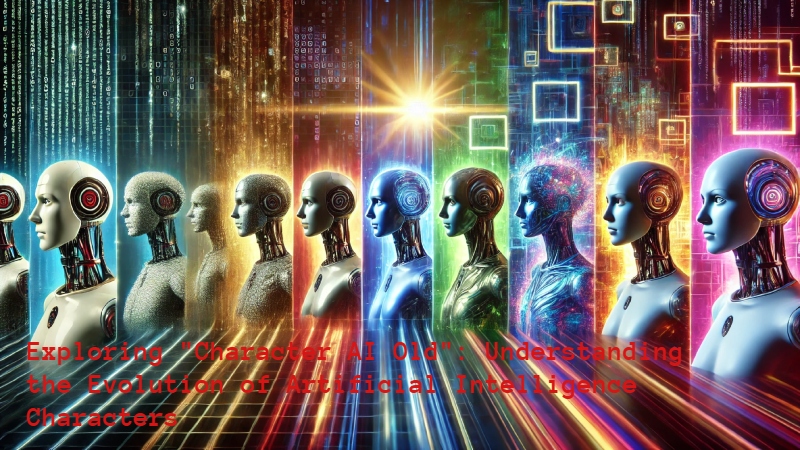Artificial Intelligence (AI) has undergone significant transformations over the years, revolutionizing industries, redefining human interaction and introducing innovative ways to engage with technology. One of the most fascinating aspects of AI is its use in creating virtual characters, often referred to as “character AI.” This article delves into the evolution of “Character AI Old,” providing insights into its origins, progression, and contemporary relevance.
The Origins of Character AI: Early Beginnings
The journey of Character AI began in the mid-20th century when scientists and researchers started exploring computational models that could simulate human-like thinking. The primary goal was to create systems replicating human conversation, decision-making, and problem-solving.
- ELIZA (1960s): ELIZA, developed by Joseph Weizenbaum in 1966, is often considered one of the earliest examples of character AI. It simulated a psychotherapist and interacted with users by analyzing their inputs and responding based on predefined patterns. While rudimentary, ELIZA laid the foundation for conversational AI, demonstrating the potential for machines to mimic human interaction.
- PARRY (1970s): Following ELIZA, PARRY was created by Kenneth Colby to simulate a person with paranoid schizophrenia. Unlike ELIZA, PARRY incorporated more advanced algorithms, making its responses contextually relevant and realistic.
- Role-Playing Games (1980s-1990s): The gaming industry played a pivotal role in advancing character AI. Early role-playing games (RPGs) like Ultima and The Elder Scrolls integrated AI-driven characters that interacted with players. Although these characters followed scripted behaviors, they set the stage for dynamic, reactive AI.
The Evolution of Character AI: From “Old” to New
As computational power increased and algorithms became more sophisticated, Character AI evolved to create more lifelike and interactive characters.
- Machine Learning Integration: The introduction of machine learning in the 1990s and early 2000s significantly enhanced Character AI. Machine learning allowed AI systems to learn from data and improve their responses over time, making virtual characters in video games, customer service bots, and educational tools more realistic and engaging.
- Natural Language Processing (NLP): Advances in NLP enabled AI characters to understand and generate human-like text. This marked a departure from the rigid, predefined responses of “old” Character AI to more fluid and contextually appropriate interactions. Systems like Apple’s Siri and Google’s Assistant exemplified this shift.
- Emotional Intelligence: Modern AI characters have been designed to recognize and respond to emotions, making interactions more natural. For example, AI-powered therapy bots like Woebot use sentiment analysis to provide emotional support, a far cry from the simplistic designs of early Character AI.
Comparing “Old” and Modern Characters AI
The evolution from “old” to modern character AI can be categorized into several dimensions:
| Aspect | Character AI Old | Modern Character AI |
|---|---|---|
| Response Mechanism | Rule-based, scripted responses | Contextual, dynamic learning |
| Interactivity | Limited, pre-programmed | Highly interactive, adaptive |
| Emotional Understanding | None | Emotionally aware |
| Applications | Basic chatbots, simple NPCs | Advanced virtual assistants, realistic NPCs |
Applications of Character AI Today
- Gaming: Video games continue to benefit from character AI advancements. AI-driven non-playable characters (NPCs) adapt to players’ actions, creating immersive experiences. Popular games like The Last of Us and Red Dead Redemption 2 showcase how far AI characters have come.
- Entertainment: AI-generated characters are used in animated films and virtual reality experiences. For instance, AI can simulate realistic crowd behaviors or develop virtual influencers like Lil Miquela.
- Customer Support: Virtual agents and chatbots now provide personalized support to users, leveraging AI to understand and resolve queries efficiently.
- Education: AI characters serve as tutors, guiding students through interactive lessons and adjusting their teaching methods based on the learner’s progress.
- Healthcare: Virtual characters assist in mental health therapy, patient care, and training simulations for medical professionals.
Challenges of Character AI
Despite its advancements, Character AI faces several challenges:
- Ethical Concerns: As AI becomes more realistic, issues of misuse and deception arise. For example, creating hyper-realistic AI characters could lead to deepfake technology being used maliciously.
- Bias in AI: AI systems can inherit biases present in training data, resulting in unfair or inappropriate behavior. Addressing this bias is a critical challenge for developers.
- Complexity: Developing truly autonomous and human-like AI characters requires immense computational resources and sophisticated algorithms.
- Uncanny Valley: As AI characters approach human-like realism, they risk falling into the “uncanny valley,” where slight imperfections make them appear eerie rather than relatable.
The Future of Character AI
Looking ahead, the future of Character AI promises exciting developments:
- Hyper-Realism: AI characters will become indistinguishable from humans in both appearance and behavior, paving the way for realistic virtual worlds.
- Advanced Emotional Intelligence: Future AI characters will better understand and respond to human emotions, enabling deeper connections.
- Integration with Augmented Reality (AR) and Virtual Reality (VR): AI characters will play a significant role in AR and VR applications, creating interactive environments for education, gaming, and training.
- Ethical AI Development: Efforts are underway to ensure that AI development aligns with ethical standards, promoting transparency, fairness, and accountability.
Conclusion
“Character AI old” represents the foundation of a rapidly evolving field that has transformed the way we interact with technology. From the early days of ELIZA to today’s emotionally intelligent virtual assistants, AI characters have come a long way. As technology advances, the potential for character AI continues to expand, promising a future where AI-driven characters are more lifelike, ethical, and impactful.
Understanding the history and progression of Character AI provides valuable insights into the broader evolution of artificial intelligence and its profound influence on our lives. As we move forward, the lessons learned from “old” Character AI will remain integral to shaping its future development.
